For many years I have been adding to a Stitch roll or Thread story roll which is a band sampler that I call For the Love of Stitching. I started stitching my band sampler in 1996 and there are many hours of pleasure represented in it. As all stitchers know as you stitch you ponder all sorts of aspects of your life. This stitch roll has definitely seen me through some good and bad times.
Before printed pattern books, embroidery designs were passed from hand to hand. Learning stitches, recording patterns and motifs on fabric for future use was was part of young girls education. This stitched reference resulted in a sampler. Samplers of the sixteenth-century were worked on long narrow strips of fabric which are called Band samplers because they were worked in a long strip or band of fabric. The width was usually between 4-9in (10-23cm) and the length was determined by the loom width of the woven linen cloth. These samplers were rolled and kept as a handy reference in a sewing box. Today we still have band samplers that are often of cross stitch designs but there is another trend of people freeform stitching on strips of fabric. These freeform samplers are called stitch rolls or story rolls.
There are a considerable number of ideas, colour schemes and patterns recorded on my band sampler, along side quotes and autobiographical story fragments. I call it a freeform band sampler, or a story roll.
The For Love of Stitching is 15 cm (6 inches) wide. It consists of different strips of fabric that are stitched together to form one long strip of needlework.
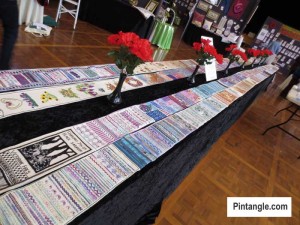 Here you can see it exhibited in 2014 at the Embroiderers Guild ACT exhibition. You can get a sense of how long it is as you can see I trouble fitting it in the frame. Click on the image to see a larger view
Here you can see it exhibited in 2014 at the Embroiderers Guild ACT exhibition. You can get a sense of how long it is as you can see I trouble fitting it in the frame. Click on the image to see a larger view
How long is stitch roll band sampler?
The For Love of Stitching stitch roll currently measures 96 feet 5 inches (2,938.78 centimeters), or 32.138 yards which is 29.3878 meters. It is still growing…
Why was the band sampler made?
 For years I have worked samplers as a personal reference and teaching aid. I stored samples in plastic page envelopes in folders decorated with hand embroidery.
For years I have worked samplers as a personal reference and teaching aid. I stored samples in plastic page envelopes in folders decorated with hand embroidery.
Many people use this method successfully but I found I was not referring to the information stored in the folders. I did not reach for them often. When stitching I was more inclined simply to repeat what was familiar and not refer to past experiments. This meant I forgot them.
I decided to try something different with my ‘doodle cloths’ and stitch explorations. I started to work band samplers that were for use as reference rather than decoration. By sheer chance on the first sample I worked I named and signed the sampler. I had no thought at the time that I would stitch so many samplers! I simply stitched “For the love of Stitching” so later after many years that became its name.
Because I could see my samples I used them as a sampler is meant to be used, as a record of stitches and ideas that can be referred to.
I have found it is easier to travel with them like this. A pile of teaching samplers stored like this are lighter and more compact than being housed in folders.
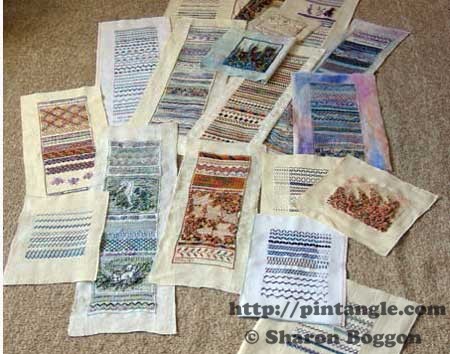
Why did you stitch them together?
I like to hand out samplers to students in workshops and lectures as people learn by touching. Unfortunately a couple of samplers were handed out, but never came back.
I stitched them together in one long strip so no one could stuff it in their hand bag. At that point my samplers became a stitch roll. To a degree this is a security measure but the other advantage is that odd samples don’t get lost.
What size will it be when done?
I dont know I will stop when I get bored with playing with it!
Is it all hand embroidery?
Yes it is. I love hand embroidery and really it has become an excuse to experiment with and explore stitches.
What fabric do you use?
Normally I use either 25 cnt linen, 28 cnt linen, or Aida but some pieces are worked on other fabrics. Tea towel linen, dress linen, evenweave linen, Aida, hardanger fabrics, Lynda, and dress cotton are all represented in the sampler. Often pieces have been hand dyed or hand painted.
In some cases I have patchworked together fabrics then used it as the foundation cloth of the sampler. In this photograph you can see what I have done.
I pieced together 25 cnt linen, cotton flanelette, Aida, hardanger fabric, table cloth linen and tea towel linen. All the pieces have been hand dyed by me using procion dyes.
They were scraps and left overs from other projects and I felt I was not wasting anything by experimenting on them.
The tacking stitches down the edge mark the edge of the sampler itself. This helps prevent me stitching into the seam line.
The white fabric along the side is scrap sheeting that I added so I could easily get the strip of fabric on a hoop. After embroidering sampler I trim the scrap sheeting off and then back it.
What thread do you use?
I use a large variety of threads such as wool, silk, cotton, stranded floss, perle cotton, bamboo and so on. Each band is different. I use both commercial threads and hand dyed threads I have dyed myself.
What dyes do you use?
I use procion dyes on both the fabric and threads.
How did you join and back the stitch roll?
If you want to know more about the process you will find information in how I Extended and backed the sampler in this article where I photographed the whole process.
Do you plan your stitch story roll?
To be honest sometimes a plan a little the other times not at all.
I try and keep things as simple as possible because I have found the more complex the project becomes the more I am less likely to do it. I will either look at it and think it’s all too much, or start it with a flurry of enthusiasm and then tire of it and I then have a UFO on my hands.
So with my sampler there is no rules. I change, fabric, stitching style, colour, thread type whenever it feels right and call it freeform improvisational samplering for a reason and it suits me. I journal on it when I feel like it and not when I dont. The only rule I have is its width. In other words in my head I say I am going to stitch a sampler 6 inches wide. That is it! I decide everything else as I go.
Why is the band sampler 6 inches wide?
My band sampler is 6 inches wide because in my hand a 8 inch hoop feels the most comfortable. While on the hoop the actual fabric is about 9-10 inches wide. I use a hoop or occasionally I put the sampler on a small stretcher.
Deciding what width the sampler is important because it is about what feels right in your hand. If you are thinking about one of these types of samplers my tip is to choose a width that you can easily experiment on. You need to be able to stitch a bit, then move on as you don’t want the sampler so wide that it takes an age to cover the area and you are tired of it after a row! Give yourself the opportunity to experiment, enjoy it then try something else, enjoy it and move on again – painlessly!
Choose a fabric width that allows for a hoop that feels right in your hand. Many people make the mistake of choosing a hoop that is too big. Some hoops will feel to big others will feel cramped so choose a hoop sixe your hand is at ease with. Try a few scrap cloths and just see what feels right. I find an 8 inch hoop is about as large as I want which means a 6 inch sampler width is good.
Once you have decided the hoop size subtract 2 inches from the diameter. So if you choose 8 inch hoop – make your sampler 6 inches wide. If you choose a 7 inch hoop make your sampler 5 inches wide. What ever width you decide on you will need a few inches of fabric either side to allow for the hoop. It’s not complex or difficult or mysterious. It is simply the width of the sampler plus a few inches so I can hoop it.
Then my freeform band sampler became a Story Roll
The sampler marks incidents or moments in history in text.
 Discovering that what is recorded becomes more interesting over time I have continued to mark events and personal history as it happens.
Discovering that what is recorded becomes more interesting over time I have continued to mark events and personal history as it happens.
 For instance above is a sampler I made after the 2009 Bush Fires in Victoria (Australia).
For instance above is a sampler I made after the 2009 Bush Fires in Victoria (Australia).
This section of the stitch roll, made in the Autumn of 2009 records what was in the news at the time. I listen to the radio as I stitch and it seemed to me that all the conversation was about Peak oil, Climate change and the ongoing global economic crisis.
I live in Australia so our Autumn is March and in that month there is also St Patricks day and we observed earth hour.
As readers can see this long band sampler has become more than a record of stitches and techniques but over time has become a contemporary freeform journal sampler as well.
Links to articles about each section:
All posts in the series are in the category the Love of Stitching Band Sampler.
Index to the sections
Sections 1 and 2, sections 3 and 4, section 5, section 6, section 7, section 8, section 9, section 10, section 11, section 12, section 13, sections 15-24, section 25 , section 26, section 27 , section 28, section 29, section 30, section 31, section 32, section 33, section 34, section 35, section 36 and section 37, section 38, section 39, section 40 , section 41 and section 42 , section 43, section 44, section 45, section 46, Section 47, section 48 section 49, section 50 section 51, (with more to come)
As I stitched this section I realised how much of a journal/autobiographical story the sampler had become.

Is this sampler the longest in the world?
Readers ask if this is the longest sampler in the world. My stitch roll might (and I emphasise might)be the longest stitched by a single person. Other stitchers have made very long samplers and story rolls too. It is not the longest band sampler in the world by far. The UK Embroiderers’ guild holds the record. You can read about it here
“With the help of over 7,000 participants of all ages and abilities from all over the world, the Embroiderers’ Guild are proud to announce that they have set a new Guinness World Record for stitching the “longest embroidery” at 605.55 metres (1,986.77 feet).”
With 7,000 people stitching it certainly is an amazing community based project. The Longest embroidery in the World is hand stitched but not an individual project but something a group of people did together.

Thread Twisties!
Experimenting with different threads can be expensive, as you would normally have to buy a whole skein of each type of thread. So I have made up my thread twisties which are a combination of different threads to use in creative hand embroidery. These enable you to try out stitching with something other than stranded cotton. For the price of just a few skeins, you can experiment with a bundle of threads of luscious colours and many different textures.
These are creative embroiders threads. With them, I hope to encourage you to experiment. Each Twistie is a thread bundle containing silk, cotton, rayon and wool. Threads range from extra fine (the same thickness as 1 strand of embroidery floss) to chunky couchable textured yarns. All threads have a soft and manageable drape so that twisting them around a needle makes experimental hand embroidery an interesting journey rather than a battle. All are threads I use. You may find a similar thread twist but no two are identical.
You will find my thread twisties in the Pintangle shop here.



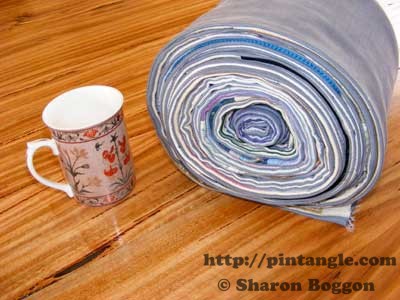
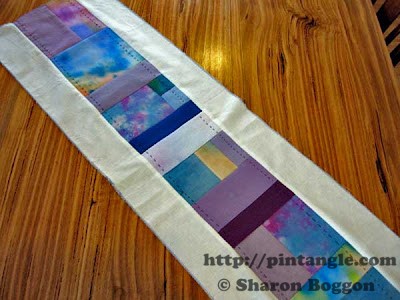
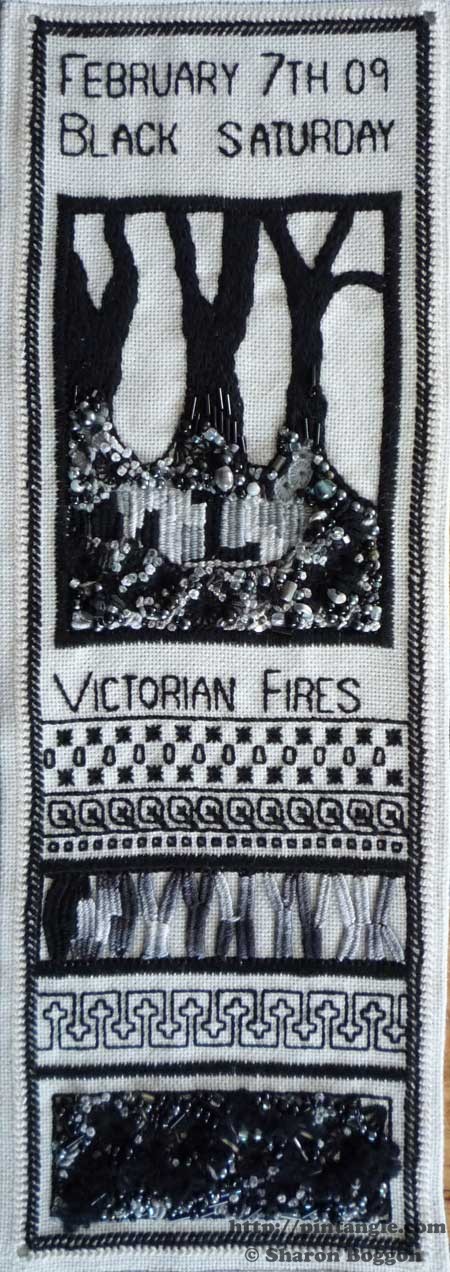
Pingback: Currently… – Cheshire Cheese
Pingback: Samples and samplers – Paper, Plastic, String – and Fabric and Thread too
Pingback: Samplers – Paper, Plastic, String – and Fabric and Thread too
how wonderful, what an achievement !
Sharon as you know I have only recently started looking at your Fb posts but I think your sampler is an absolute joy and inspiration to so many of us. I love that it is just 6 inches wide. It seems so manageable at that size! I also love the way you have made it a journal too. Wish I had started when I was younger with all the life events shown.(63 now)! You are so generous with your expertise. Thank you!
I *LOVE* your sampler band. i think maybe 6 inches wide is a good width. I just did a crazy stitch sampler that was 8 inch by 8 inch square. It doesn’t sound big, but it was. And I had to move the hoop. I choose that size because I cut my material 12 inches wide and very long. I considered on just continuing down the long piece, but didn’t. However, I kind of like pieces hung on the wall for reference, but also like the band idea. Hmmm… Decisions. Thank you for sharing your wonderful work.
By the way, I think you might have the longest *individual* sampler band.
Debbi
Thanks for your lovely comment. I have found 6 inches to be very practical – it will fit an 8 inch hoop which is a very easy size to use. I would test the width first then decide as if you find it too wide you will not continue doing it.
Anyway Have fun it is a very rewarding way to learn stitches!
I have been trying in vain to read The Tale of Two Samplers on your former web site. Do you still have access to that information. A friend gave me one of Dorrit’s autographed boxes which had belonged to her mother and I was going to take it to our EGA Show and Tell with, hopefully, a bit of information. thanks in advance and this site looks great!
Dee Ragsdale
Dee the Tale of two samplers is not on my former website it was on the Whitman’s Chocolate website but they have removed it. I am not responsible for another website removing material. Your best tactic I think would be to write to Whitman’s chocolates
Pingback: Sheep Pincushion finished | Nellie Makes
Wow that is wonderful, you have inspired me to stitch my own sampler on a roll! Thank you !!
Great to hear Amanda – the thing that is fun is that you can keep adding to it as you feel like it. If you get tired of it for even a year a two you can always return to it
Pingback: My Sampler Project | Tenar's cave
Having just discovered you and all your information etc I must add to what has been said You truly are generous and have a kind heart to help as you do! From South Africa I salute you Helene
sharon gracias por tus enseñanzas,me gusta bordar a pesar de mi dolor de manos, pero te sigo, de ti he aprendido mucho, siempre abro mi correo con la ilusion de aprender más. un abrazo
I too found you sort of accidentally, but I am so glad that I have. What amazes me even more than your talent is your generosity. That you so freely share your knowledge is awesome. I purchased your crazy quilt templates (where have these been for the last few years since I found crazy quilting? They are AMAZING…..). if you are interested at all in crazy quilting, these templates are a must have. Your stitch how to’s are brilliant and I am so determined to use your diamond block crazy quilt ideas in my next doiley quilt. It is just beautiful and thank you so much for your blog, your teaching and sharing of your amazing talent. Many, many thanks. Donna
Sharon, I hit your site by accident, and it is your fault, I can’t seem to leave and get my chores done. I am relatively new to Crazy Quilting, and absolutely love the embellishing process. You are SO talented.. my hope is to become better, but you truly are a shining star!! Thank you for the inspiration and knowledge you share.
One totally endearing piece!! What a treasure!
Hello,
I am wondering if there is an online program that can help print my patterns on mesh/fabric that I would then embroider over?
I am not aware of such a program
What a beautiful piece of work but I work on CANVAS. I love doing the different states on either 14 count or 18 count. Because of 3 now ging to be 4 on Friday, even with magnifying classes I can not go to Congress cloth. Does this mean I should not take any of your other classes besides Artists journal. Even though I am not 100% I want to teach needlepoint using the fun composite embroidery stitches, canvas sie dependent on age of class.
I would appreciate any advice
Thank you
Sharon Z
I have finally started my very own sampler-on-a-roll! (yes, I am totally in love with your masterpiece and hope to grow my own — it’s a mere 42 1/2″ now). Thank you for the inspiration and the instruction on so many stitches …. I am slowly working my way through this year’s TAST (but am woefully behind!)
wow, I was going to say what dedication – but that made it seem like work so instead I’ll say “What love and joy”
Thankyou for all the patience you have in explaining stitches in detail.You inspire me whenever I visit your site.
Thanks for sharing.
This is a lovely band, and a great ongoing accomplishment. Makes me think of a project to create a stitched diary in page form – similar to your band. The greatest sense I get from reading the history of this band is something I fully relate to – that is, how those of us who love to stitch are fulfilling a need to both expose and express ourselves. Thank you for sharing.
Thank you Laurel that is a lovely comment.
Hi Sharon
I keep coming back here – I love your band sampler and it must surely be up for the Guiness Book of Records now? I also love that it has become a place to journal as well making it so personal to you. What an inspiration! Makes me wish I was a lot younger and my hands were not so painful.
Thanks so much for all you do
Sara
Thanks Sara for such a lovely comment. Sunday morning here and its nice to open my comments and be greeted with this.No its not in the Guiness book of records but then I have never applied to have it there. Also I have another few strips to add since the last lot. So it will be longer soon.
Beautiful words, well said and stitched.
Barbara